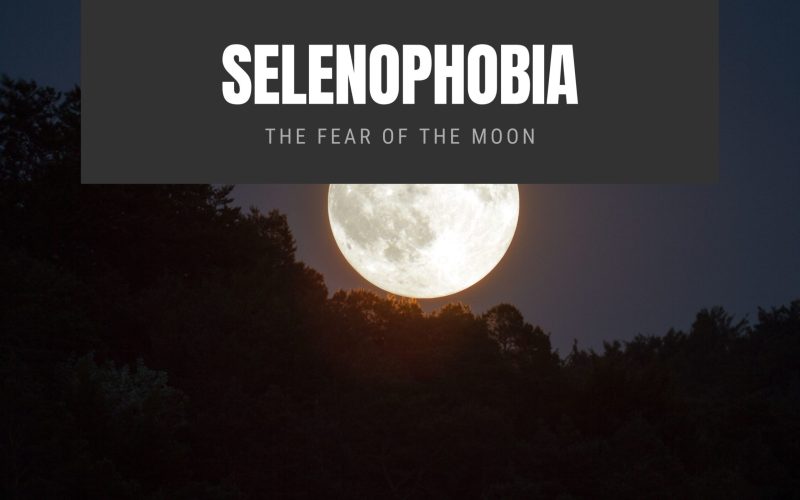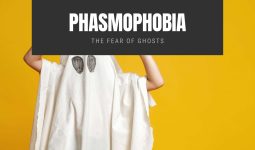This phobia seems one of the oldest, as the moon triggers it. As you already know, has been around for ages. Selenophobia is the overwhelming or severe fear of the moon.
It is coined from Greek words “Seleno” which stands for the moon and “Phobos” which stands for fear.
It is also referred to as Lunaphobia, coined from “Luna,” the Latin word for moon, and “Phobos,” which means fear.
The word “Lunatic” is also coined from this word with the notion that there’s an increase or decrease in the severity of their illness with the lunar cycle.
For example, it is believed that during the Full moon, their mental illness is at its peak.
Myths, folklore, and superstitious beliefs have surrounded the moon for ages. In some cultures, people worship and offer sacrifices to the moon.
Also, the legends of werewolves, vampires, Draculas, witches, Halloween, and the full moon have only increased this fear.
About 1 in 1.5 million persons have this phobia. It is characterized by a feeling of anxiety at the sight of the moon or severe anxiety, knowing that night is approaching.
People with this phobia tend to have Achuluphobia, which is the fear of the dark. They are also predisposed to have Spacephobia, the Fear of Space; Sanguivoriphobia, the Fear of Vampires; and Samhainophobia, the Fear of Halloween.
People who suffer from selenophobia are prone to suffer from Mestoselenophobia, which is the fear of the Full moon, and this is due to the legends surrounding the Full moon.
Most selenophobics tend to stay up at night so that they can stay alert and fight whatever might come to attack them.
This also pushes them to take up night jobs to work at night and sleep during the day.
Symptoms of Selenophobia
- The feeling of anxiety once the moon is seen
- Avoidance of the moon
- Insomnia and sleep disorders
- Refusal to go out at night
- Hot flashes
- Hyperventilation on seeing the moon, whether on TV or in reality
- Pounding of the chest, increased heartbeat
- Severe sweating
- Panic attacks
- A selenophobia might faint at the sight of the moon.
- Obstruction of moonlight getting into one’s house by drawing the curtains close.
- Fear of nighttime approaching.
- Temporary paralysis
- The feeling of dread and intense fear
- Delusions and hallucinations
Causes of Selenophobia
Past Traumatic Experience
In this case, the moon might have little to do with this experience other than being visible. If a person met harm or an accident when the moon was obvious, this could trigger PSTD any time the person sees the moon.
Also, the moon controls tides on Earth, which is a source of worry to people as they fear the moon might get out of control one day.
The absence of the moon from the sky at night is also a trigger of this phobia as they might think something has happened to the moon or that the moon will soon fall to Earth.
Media
The media (Movie Industry) is not helping; they only fuel this phobia. Hollywood, especially since it is really good at making viewers see the moon as an eerie celestial body.
Also, thanks to the internet, many conspiracy theories on the moon are easily available at just the swipe of a finger.
Legends, Folklores, and Myths
There are lots of legends and myths surrounding the moon. These legends create fear in the minds of people, thereby making them selenophobic. Also, there is readily available folklore to feed this fear.
Associated (passive) Triggers
The association of wolves, dogs, and vampires to the moon creates endless fear in people. Once the aforementioned are sighted or imagined by selenophobics, it triggers panic attacks.
- Learning and Culture: In some cultures, the Full moon is associated with crime and time filled with woes. In such a cultural setting, the number of selenophobics will be on the high side. Also, selenophobia can be learned from a loved one who is experiencing it.
Halloween
Halloween is the celebration of evil and the dark side. Just this meaning explains a lot of things about this obscene celebration.
The moon is greatly associated with Halloween as a lot happened during this period, such as multiple cases of missing children, murders, high crime rates, haunted houses, etc.
Treatment for Selenophobia
This phobia, as easy as it is to treat, becomes quite the challenge if the selenophobic patient blatantly refuses to leave their home and interact with other triggers, which in this case is the moon.
Psychotherapy and hypnotherapy are major treatments applied for selenophobia. Below are the detailed treatments for selenophobia:
1. Hypnotherapy
Hypnosis, or in this case, hypnotherapy, is the science of putting the patient in a very relaxed, sleep-like state of mind and probing the patient to identify the root of a problem.
Psychiatrists and psychotherapists usually apply this in the treatments of mental disorders and illnesses, phobias inclusive.
This would normally be used in the treatment of selenophobics who are suspected of becoming that way via traumatic experience. It could also be used as a form of diagnosis.
2. Psychotherapy
In the case of selenophobia, the counselor, in a controlled and gradual process, decreases the anxiety of the selenophobic patient and helps them develop new thought patterns and positivity on the trigger, which is the moon.
3. Desensitization
Desensitization is a behavior reformation technique used especially in treating phobias, in which panic or other undesirable emotional responses to a given stimulus are reduced or extinguished, especially by repeated exposure.
This is to say that the stimulus (trigger), the moon or the idea about the moon, is gradually replaced with positive thoughts and affirmations. This process doesn’t just occur at once; rather, it is gradual.
Desensitization works with role-playing, as one must face the trigger (fear).
4. Exposure therapy
Exposure therapy is a set of procedures that involve the confrontation of a feared trigger, either in real life or in imagination.
When applying this, the counselor or psychotherapist encourages the selenophobic patient to go out when the moon is out or at night. It is a gradual process and should not be rushed as this might worsen the fear instead of helping the patient out of it.
5. Use of Anti-anxiety medications
Due to panic attacks experienced by Selenophobics, some Anti-anxiety medications recommended include Xanax, Valium, Klonopin, etc.
These drugs are not to be taken daily. In no way should they be abused. Directives from your healthcare provider should be received before the purchase and consumption of these drugs to avoid abuse and also to get a qualified recommendation.
6. Self Care
The selenophobic patient, with the help and support of a counselor and loved ones, should do the following:
- Build self-confidence.
- Live healthy by eating an adequate diet and exercising.
- Avoid a Sedentary lifestyle such as smoking, etc.
- Give pep talks to oneself.
- Spread positive energy
- Make and affirm positive confessions.
- Build self-confidence.
- Build Healthy self-esteem.
- Engage in spiritual Exercises.
- Engage in more and better social activities, especially when the moon is out.
- Seek therapy, etc.








